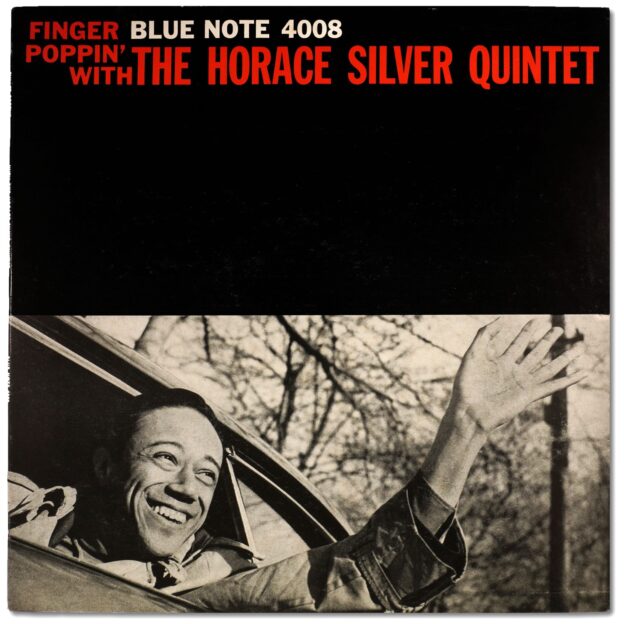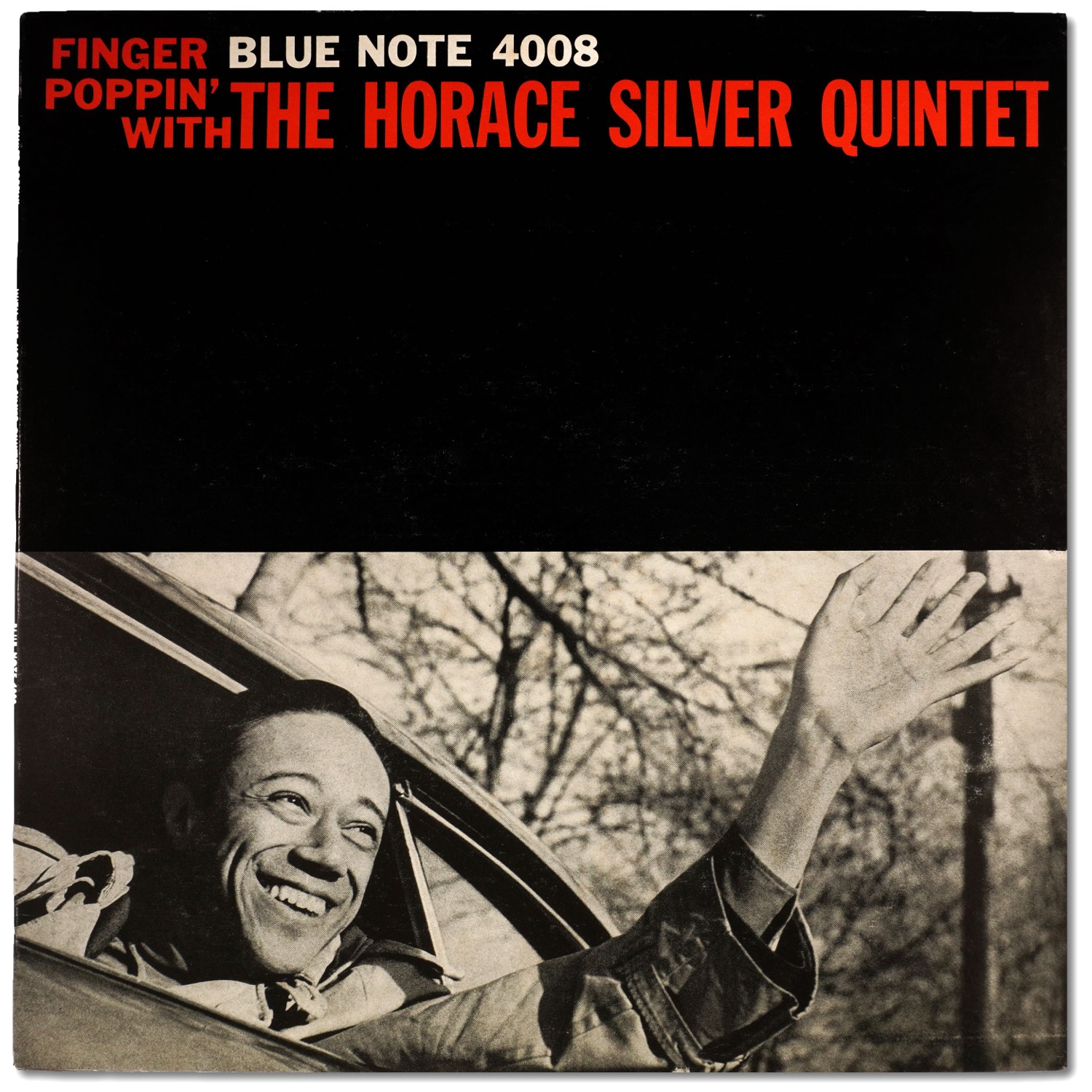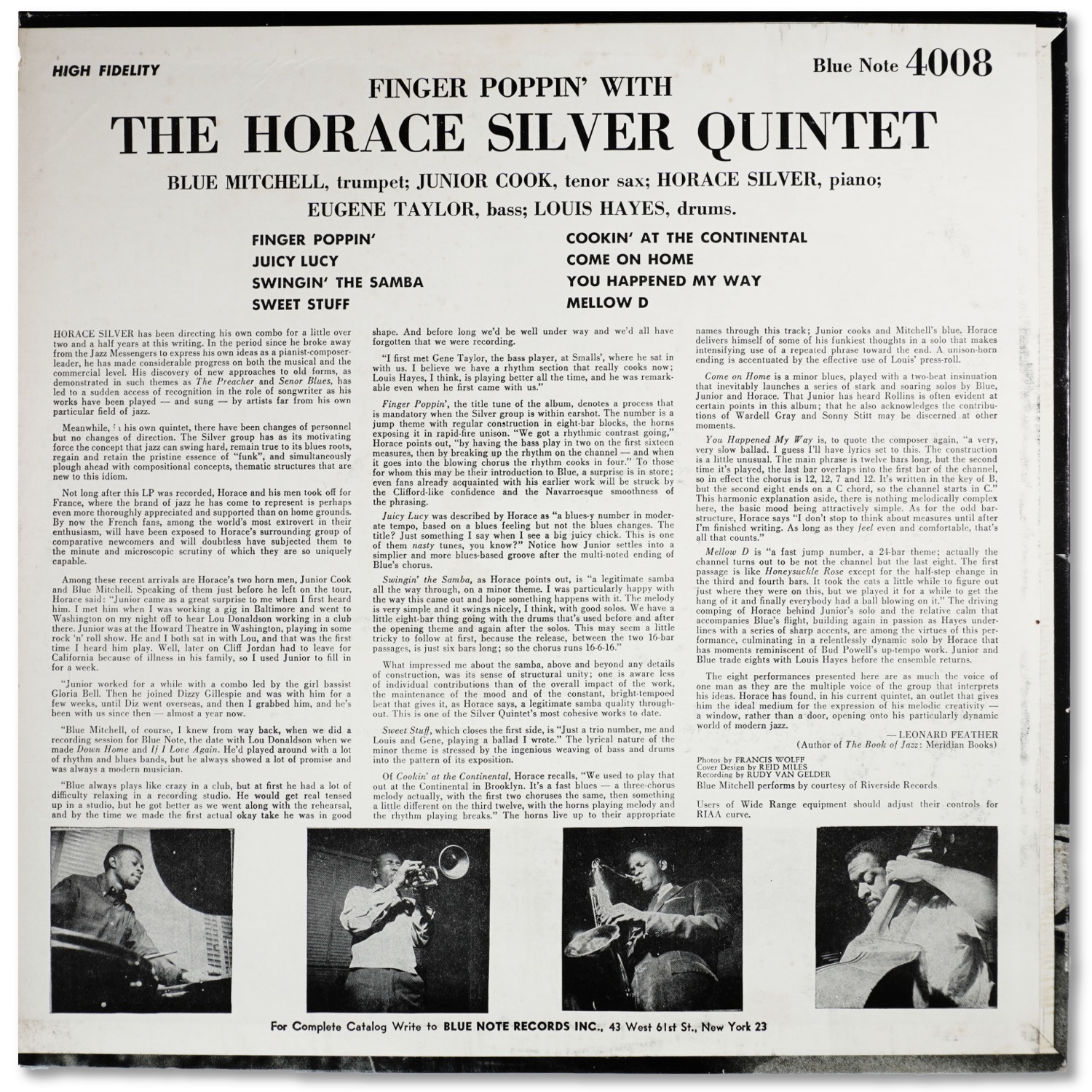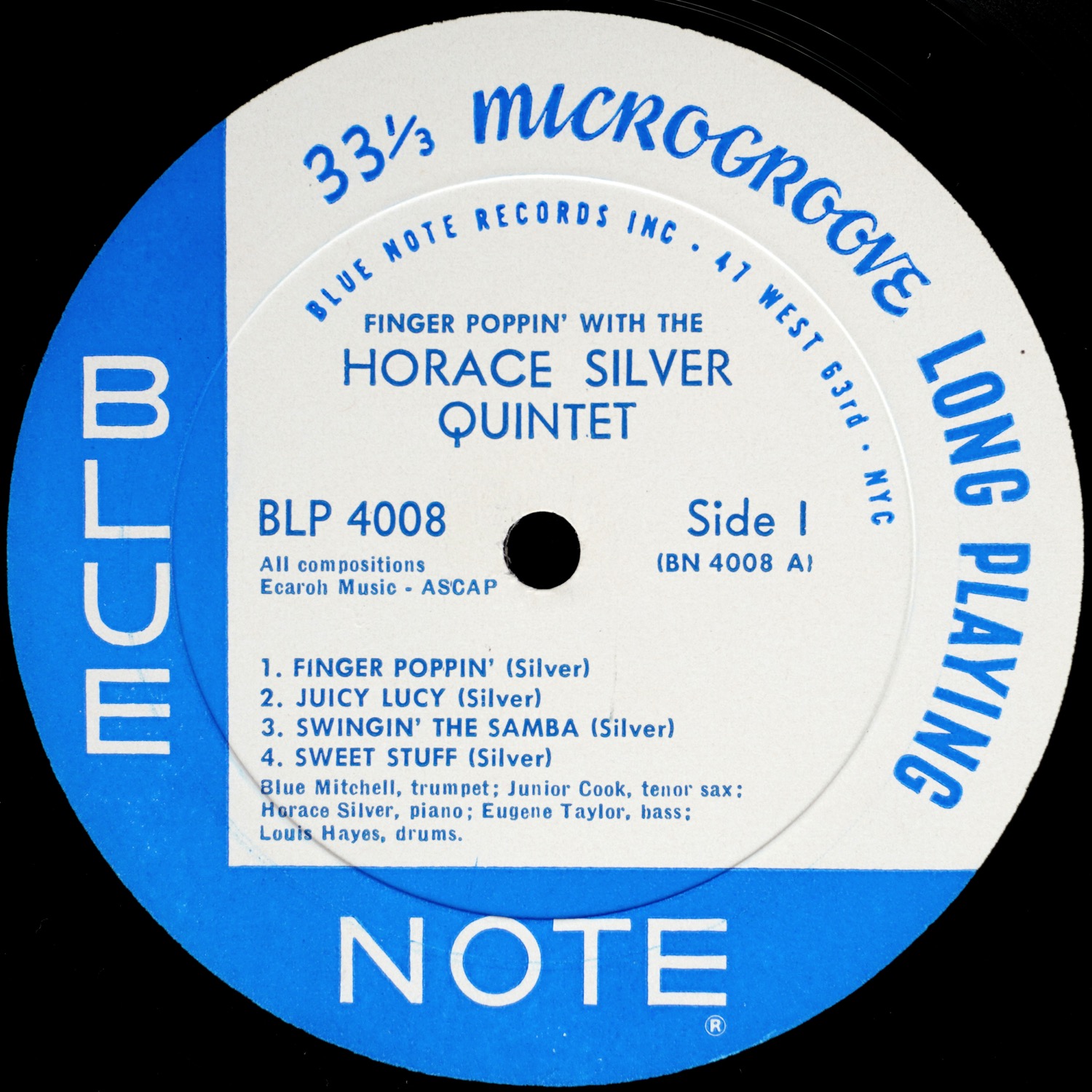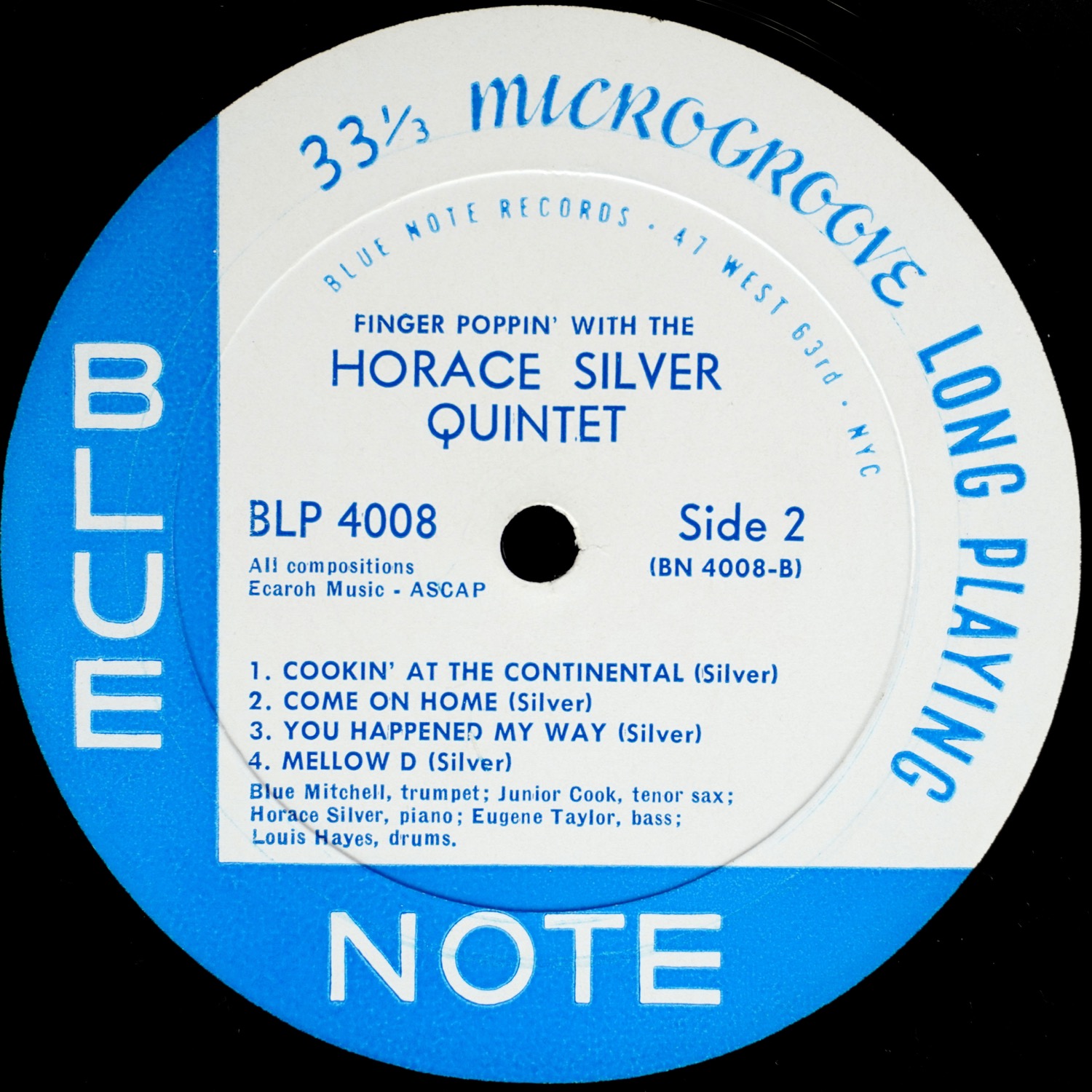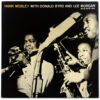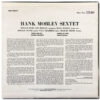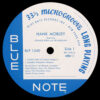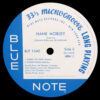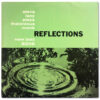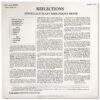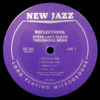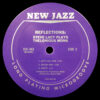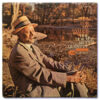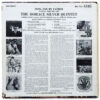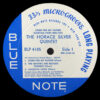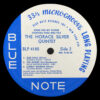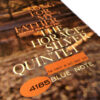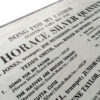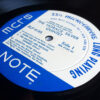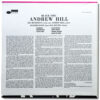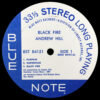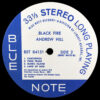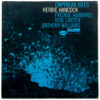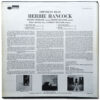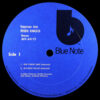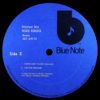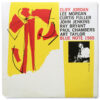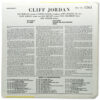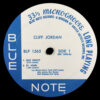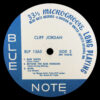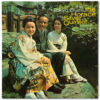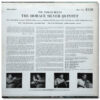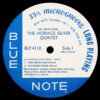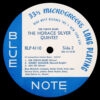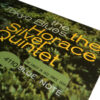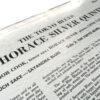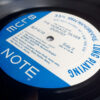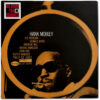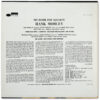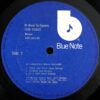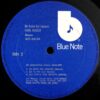- “Earless” Liberty mono pressing ca. 1966
- “RVG” stamped in dead wax
Personnel:
- Blue Mitchell, trumpet
- Junior Cook, tenor saxophone
- Horace Silver, piano
- Eugene Taylor, bass
- Louis Hayes, drums
Recorded January 31, 1959 at Van Gelder Studio, Hackensack, New Jersey
Originally released February 1959
| 1 | Finger Poppin’ | |
| 2 | Juicy Lucy | |
| 3 | Swingin’ The Samba | |
| 4 | Sweet Stuff | |
| 5 | Cookin’ at the Continental | |
| 6 | Come on Home | |
| 7 | You Happened My Way | |
| 8 | Mellow D |
Selection: “You Happened My Way” (Silver)
After doing a little research, a controversial Music Matters online article led me to the incorrect conclusion that Blue Note albums recorded after Halloween 1958 were intended for stereo release despite their mono counterparts being more valuable. So I found an original stereo copy via eBay Buy It Now (this was one of the earliest Blue Note stereo albums with the rectangular gold “STEREO” sticker). This copy was overpriced, over-graded, and didn’t sound much better than my mono copy.
A couple years went by without my giving much thought to vintage jazz records when I decided to give the hobby another go. Around this time I got lucky winning an auction that ended on a weekday morning for a very fair price, and that record is being presented here. It has its fair share of pops and ticks but it’s managed to remain in my collection because it’s wear-free, it’s a first pressing, and the cover and labels are both in great shape.
Shortly after acquiring this copy through the mail, I debated on whether I preferred the stereo or mono version of this album. I remember liking how I could hear all of the nuances of Louis Hayes’ drum kit on the stereo copy, but I also didn’t like the way Horace Silver was crammed in the left-hand corner of the mix along with the trumpet. Both mixes had their pluses and minuses, but after doing a lot of research I came to the conclusion that this album was meant to be heard in mono so I sold my stereo copy largely on principle. (Someday I might buy another original stereo copy, though. The spread was super-wide and it was a real treat to hear Louis Hayes’ drumming in such isolation.)
It’s fun to reminisce about the early days of my collecting, back when it was all so new and fresh to me, back when I had as much first-hand experience with mono Blue Note originals as I had with unicorns, back when I would marvel at the value of mono Blue Note originals in the Goldmine price guide. It’s crazy to think about how far removed I am from that place today both in terms of knowledge and experience. I’m a wiser collector with the collection to prove it but I do miss that sense of wonder.
This isn’t one of my favorite Horace Silver albums but it does include some of my favorite songs. I played the title track over and over again when I was auditioning my various copies of this album and it stuck with me. To this day, the opener’s frantic bebop is an exhilarating listen and has ultimately served as my introduction to the legendary, bold mono sound of original Blue Note pressings. “Sweet Stuff” is in the Silver tradition of syrupy ballads like “Shirl” and “Lonely Woman”, though that doesn’t make it any less enjoyable of a listen. And despite it not standing out initially, “You Happened My Way” is a beautiful melancholy number that has since become a favorite Silver composition.
Someday I’d love to own a clean first pressing of this album, which in all likelihood wouldn’t cost me an arm and a leg. Luckily, Silver was a very popular artist in his day so I reckon that the chances of this happening are pretty good.
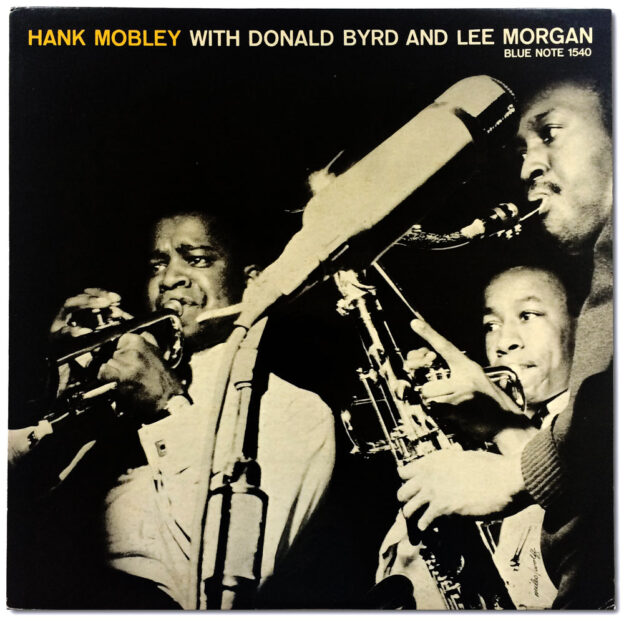
Vinyl Spotlight: Hank Mobley with Donald Byrd and Lee Morgan (Blue Note 1540) Toshiba Reissue
- Japanese Toshiba reissue circa 1983 (BN 1540)
Personnel:
- Donald Byrd, trumpet
- Lee Morgan, trumpet
- Hank Mobley, tenor saxophone
- Horace Silver, piano
- Paul Chambers, bass
- Charlie Persip, drums
Recorded November 25, 1956 at Van Gelder Studio, Hackensack, New Jersey
Originally released January 1957
Selection: “Touch and Go” (Mobley)
Selection: “Double Whammy” (Mobley)
There was something different about this sound, though. The horns had a tremendous sonic impact. The unique arrangement of two trumpets and one tenor saxophone was certainly playing a role, but recording engineer Rudy Van Gelder had clearly found a rare synergy with his equipment that day and I have yet to hear this horn sound topped by any other jazz recording. It is intense, smooth, and cohesive all at once. Van Gelder was getting a similar sound on other albums in late 1956 but perhaps the particular combination of Mobley, Byrd, and Morgan sets this album apart. The engineer’s choices regarding microphone positioning, preamplifier gain, compression, and instrument balance certainly played a role in the creation of this monumental sound as well.
The album’s compositions, all written by leader Hank Mobley, are consistently menacing. The haunting harmonies of “Touch and Go” and “Double Whammy” carry a sense of foreboding, and while “Barrel of Funk” has a rather upbeat “A” section, the tune ultimately transforms into an intriguing progression of minor-key origins at its bridge. Even the album’s most upbeat tune, “Mobleymania”, manages to keep listeners on the edge of their seats with harmonic tension.
Blue Note catalog number 1540 features Mobley’s characteristic sweet, smooth tone throughout. As a youthful pair of trumpeters, Donald Byrd and Lee Morgan are difficult to tell apart. Horace Silver does little to detract from this star-studded frontline, and the forefather of bop humbly yet tastefully blends into the background for much of the program. Silver’s comping is never boastful here, but at the same time it falls short of embodying the pianist’s big musical personality and signature funk (it wouldn’t be long before Silver would ditch sideman work for good and become the leader of his own legendary quintet). To round things out, drummer Charlie Persip sits at the throne behind his drum kit in the far corner of Rudy Van Gelder’s living room studio. I cannot get enough of the beautiful simplicity of Van Gelder’s mono drum sound at Hackensack in the late ’50s. Persip sounds just as good as anyone in that room and his straight-ahead timekeeping compliments Van Gelder’s technique exceedingly well.
Beyond a repress in the late ’60s after Blue Note had been sold to Liberty Records (the proof of which lies in the existence of copies with “RVG” etchings but no “ear”), this album has never been reissued in the United States, not even on compact disc (it has, however, appeared on numerous compilations including Mosaic’s box set of Mobley’s ’50s Blue Note recordings). The Japanese almost never left a Blue Note stone unturned though and this album is no exception, having been reissued by Toshiba-EMI five times in various formats. I was also considering the King reissue from the same year when I bought this 1983 Toshiba copy on eBay from a Japanese seller but ultimately chose the Toshiba not only because it was cheaper but I also noticed that the fonts used on the Toshiba cover more accurately portrayed those of the original artwork (King album covers also often admit an unnaturally high level of contrast). This was my first Japanese Blue Note vinyl reissue venture and I remember being stunned by how dead-quiet this pressing was.
My dream is to someday own a vintage copy of this album with RVG etchings. Until then, this Toshiba reissue is sure to get lots of turntable time in my house.
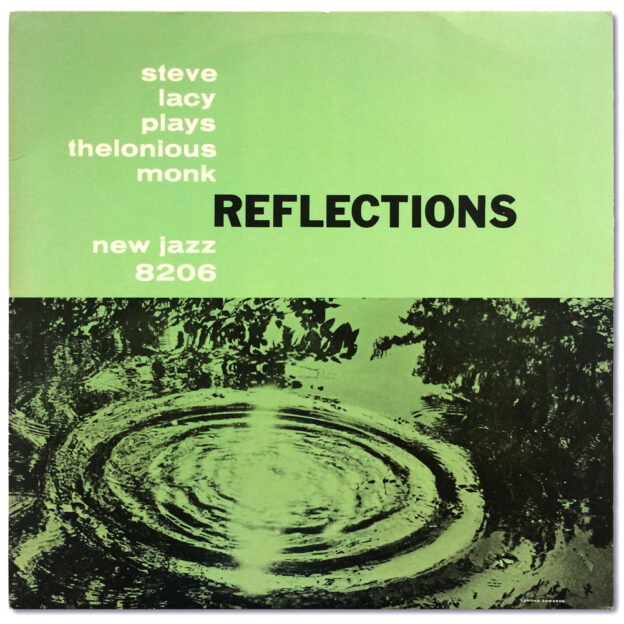
Vinyl Spotlight: Reflections: Steve Lacy Plays Thelonious Monk (New Jazz 8206) OJC Reissue
- Original Jazz Classics reissue circa 1983 (OJC-063)
- “GH” etched in dead wax (side 2 only)
Personnel:
- Steve Lacy, soprano saxophone
- Mal Waldron, piano
- Buell Neidlinger, bass
- Elvin Jones, drums
Recorded October 17, 1958 at Van Gelder Studio, Hackensack, New Jersey
Originally released in 1959
Selection:
“Reflections” (Monk)
On this expedition I had the luxury of being able to preview records as I dug, and when I put this record on I was surprised by how much I liked what I was hearing. I quickly realized that Lacy had chosen more obscure, challenging Monk tunes for the album. Wynton Marsalis did something similar when I saw the Lincoln Center Jazz Orchestra pay tribute to Monk at Town Hall in New York City in 2016 and I admire the bravery that goes into making this kind of choice.
Not to discredit Lacy’s chops (of which he has plenty), just the combination of Monk’s music being played with soprano sax is a treat in and of itself. Lacy and session pianist Mal Waldron are clearly big fans of Monk’s, each having recorded Monk tunes numerous times throughout their careers. Considering how much I enjoy this album on top of its condition and the price I paid, this has become one of my favorite records in my collection.
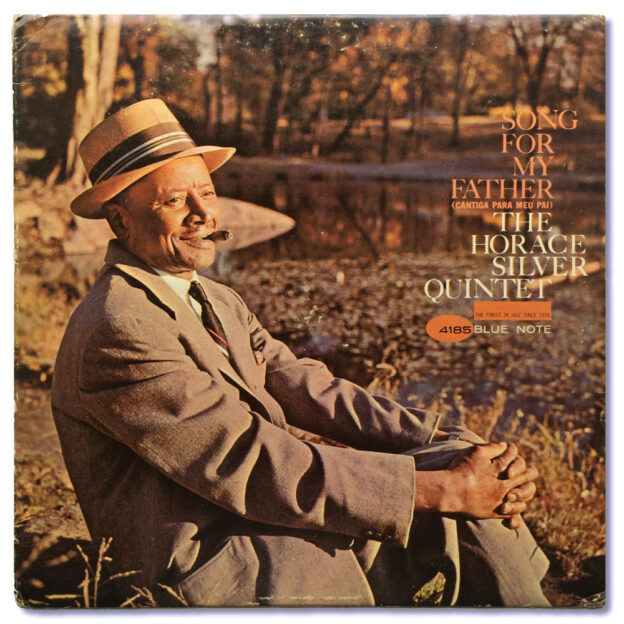
Vinyl Spotlight: The Horace Silver Quintet, Song for My Father (Blue Note 4185) Original Mono Pressing
- Original 1964 mono pressing
- “NEW YORK USA” on both labels
- Plastylite “P” etched and “VAN GELDER” stamped in dead wax
- Deep groove on side 1
- “43 West 61st St., New York 23” address on jacket without “Printed in U.S.A.”
Personnel:
All but “Calcutta Cutie”, “Lonely Woman”:
- Carmell Jones, trumpet
- Joe Henderson, tenor saxophone
- Horace Silver, piano
- Teddy Smith, bass
- Roger Humphries, drums
“Calcutta Cutie”, “Lonely Woman” only:
- Blue Mitchell, trumpet (“Calcutta Cutie” only)
- Junior Cook, tenor saxophone (“Calcutta Cutie” only)
- Horace Silver, piano
- Gene Taylor, bass
- Roy Brooks, drums
“Calcutta Cutie” and “Lonely Woman” recorded October 31, 1963
All other tracks recorded October 26, 1964
All selections recorded at Van Gelder Studio, Englewood Cliffs, New Jersey
Originally released December 1964
| 1 | Song for My Father | |
| 2 | The Natives are Restless Tonight | |
| 3 | Calcutta Cutie | |
| 4 | Que Pasa | |
| 5 | The Kicker | |
| 6 | Lonely Woman |
Selection: “Lonely Woman” (Silver)
It makes sense that Song for My Father is part of many peoples’ introduction to the jazz genre. It is not only an essential part of the classic jazz canon, it is also a very accessible album. The minimalist structure of “Calcutta Cutie” and “Que Pasa” should cause just about anyone’s ears to perk up and listen. The album has everything: accessible tunes, a radio-friendly title track, two cooking sessions, and a gorgeous ballad. It certainly was one of the first albums I sought out. I first had the Rudy Van Gelder Edition CD, but when I started collecting jazz vinyl, this album was definitely near the top of my wish list.
The first time I came across an original pressing was at the Jazz Record Center in New York City. It was pretty exciting: I had just recently begun collecting and they had both original mono and stereo copies; I went for the mono. Though the record looked pretty darn clean when I bought it, to my dismay I later discovered that it suffered from audible groove wear. I bought another original mono copy on eBay with the same result before I got this copy via Buy It Now from a German seller. Although its visual condition is really only VG+, this copy is one of those rare instances where a vintage jazz record is scuffed up but free from groove wear and thus plays better than it looks.
My favorite song on this record is perhaps my favorite ballad of all time, “Lonely Woman”. It’s the last song on side 2, and because it’s the last song on the side I was faced with a particular dilemma. The phenomenon of inner groove distortion makes the innermost tracks on each side of a record more susceptible to groove wear, and this is exactly why my first two copies ended up for sale on eBay. Piano is an instrument especially prone to causing mistracing in the presence of groove wear, and on a ballad like this, that distortion is going to be easier to notice if it’s there. If you can find a Rudy Van Gelder-mastered original that’s free from groove wear like this one, the plus side to the engineer’s aggressive mastering techniques is that the music usually overpowers surface marks even in the most excessive of instances; listen above to hear the results.
Whereas my copy of this album has a deep groove on side 1 only, Fred Cohen’s Blue Note guide indicates that copies exist with deep grooves on both sides. But note that Cohen is very clear on page 77 of his guide when he explains the significance of deep grooves when evaluating the vintage of a Blue Note record:
“After a certain point, it can never truly be known whether similar pressings for the same record, whose only difference is the presence or absence of a deep-groove on one, both, or neither labels, is actually the original FIRST pressing. But since collectors have a natural bias for any detail that suggests an early or original issue, the presence of a deep-groove has been treated in this guide as an indication of an original, but ONLY an indication.”
Each of us is free to agree or disagree with him (I happen to think his scientific approach to the issue is exactly right) but I discourage the interpretation of the deep groove data in his guide as a definitive end-all-be-all as to what constitutes a first pressing for Blue Note albums released after the appearance of the first non-deep groove copies in 1961. There is no hard evidence suggesting that either deep groove or non-deep groove pressings of these albums always came first. For someone like myself, this means that in the event that all the other appropriate indicators are there, both deep groove and non-deep groove pressings should be considered first pressings. So if you have a copy of this album with the Van Gelder stamp and the “P” but no deep grooves, my advice is to consider it a first pressing.
The sound of this album is characteristic of Rudy Van Gelder’s work in the mid-1960s. As early as 1963 (see Lee Morgan’s The Sidewinder), one can hear Van Gelder pushing his compressors harder than ever, resulting in a saturated, thick sound. Horns meld together like glue, piano notes come thundering down like hammers, and drums have an in-your-face presence where each and every nuance is amplified to cut through the mix. Of the sides presented here, “Song for My Father” embodies this sound the most.
This album is a bonafide classic. It is yet another Blue Note staple filled with brilliant music, an album that beckons to be listened to from start to finish every time.
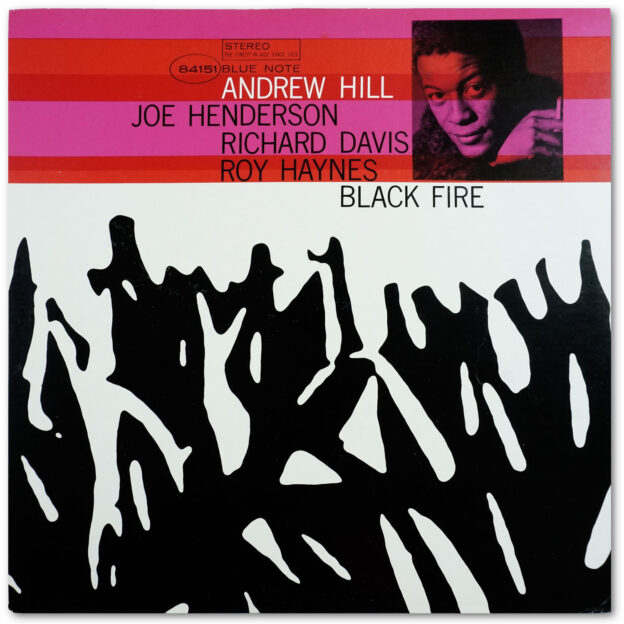
Vinyl Spotlight: Andrew Hill, Black Fire (Blue Note 84151) Liberty RVG Stereo Pressing
- Stereo Liberty reissue circa 1966-1970
- “A DIVISION OF LIBERTY RECORDS, INC.” on both labels
- “VAN GELDER” stamped in dead wax
Personnel:
- Joe Henderson, tenor saxophone
- Andrew Hill, piano
- Richard Davis, bass
- Roy Haynes, drums
Recorded November 8, 1963 at Van Gelder Studio, Englewood Cliffs, New Jersey
Originally released March 1964
| 1 | Pumpkin | |
| 2 | Subterfuge | |
| 3 | Black Fire | |
| 4 | Cantarnos | |
| 5 | Tired Trade | |
| 6 | McNeil Island | |
| 7 | Land of Nod |
Selections:
“Pumpkin” (Hill)
“Black Fire” (Hill)
First and foremost, I think this is one of the greatest album covers of all time. I love the juxtaposition of the bold strips of various red hues with the cartoony black-and-white illustration of fire beneath. Reid Miles’ cover design speaks volumes and yet again complements the music incredibly well.
From the time Andrew Hill arrived at Blue Note in 1963, it didn’t take long for the pianist-composer to venture “out” and away from bop. Hill first recorded for the label in September of that year with Joe Henderson (Our Thing, Blue Note 4152), then with Hank Mobley the following month (No Room for Squares, Blue Note 4149). Black Fire, Hill’s first album as a leader for Blue Note, was recorded in November 1963 and gives us an early glimpse at Hill loosely conforming to the higher degree of harmonic and melodic structure commonly found in bop. Blue Note would continue to document Hill’s musical explorations in the coming months, laying to tape Smokestack, Judgment!, then finally Hill’s avant-garde classic Point of Departure in March 1964 — the same month that Eric Dolphy recorded his landmark album Out to Lunch! for the label.
This album is about as far out as I’m willing go into the free jazz sea. I’m not a fan of free jazz and don’t know much about it, but from the little I do know I’m willing to say that Black Fire tows the line between post bop and the avant-garde. The sounds here tend to invoke a subtle feeling of panic, but much like another favorite mid-sixties quartet album of mine, Black Fire maintains a surprising degree of calm and quietude through all of the chaos. We also get to hear Roy Haynes on an uncommon Blue Note date and he doesn’t disappoint, demonstrating his patented pinpoint precision and tight snare drum work throughout.
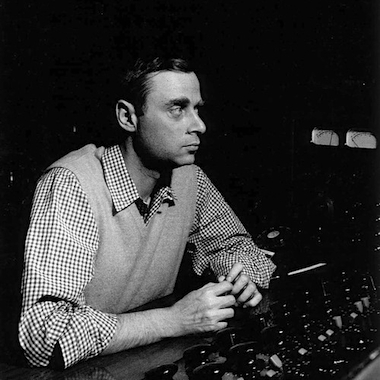
Spotify Playlists: Rudy Van Gelder Studios
Rudy Van Gelder is one of the most recognized audio engineers to have ever lived. He has recorded hundreds of the most celebrated jazz albums the world has ever heard. His recordings are so characteristic, “the Van Gelder sound” has become a catchphrase known to jazz fans the world over. But under the umbrella of this moniker, Rudy Van Gelder’s recording technique, philosophy, and logistics went through numerous changes over his career. Perhaps the change that affected this sonic signature most was when he moved his studio from his parents’ living room in Hackensack, New Jersey to a custom-built, cathedral-like structure in nearby Englewood Cliffs. The following playlists should make clear the distinct sonic characteristics of each studio and the way each space left its mark on recordings:
- Hackensack Mono: This playlist embodies the immediate, up-front sound of Van Gelder’s Hackensack home studio. Additionally, since mono was the singular focus here, this playlist consists entirely of mono recordings and thus embodies Van Gelder’s legendary mono sound from start to finish.
- Englewood Cliffs: The stereo presentation of each recording here helps to emphasize the open, spacious sound of this studio.
Click the links below to listen to the playlists on Spotify, or shuffle through the playlists right here!
Note: If you are not logged in to Spotify on your web browser, clicking one of the “play” icons above will only play 30-second clips of the songs. Click any of the embedded links to sign in, open Spotify in your browser, or launch the app on your computer.
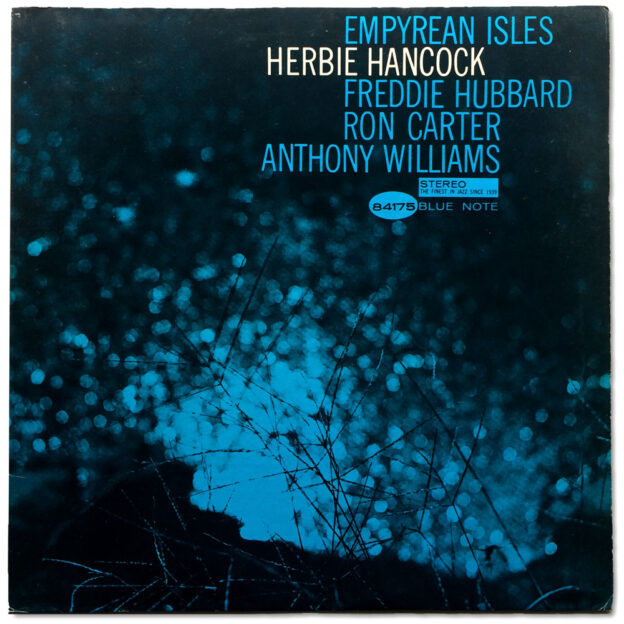
Vinyl Spotlight: Herbie Hancock, Empyrean Isles (Blue Note 4175) UA RVG Stereo Pressing
- United Artists stereo reissue circa 1972-1975
- “VAN GELDER” stamped in dead wax
Personnel:
- Freddie Hubbard, trumpet
- Herbie Hancock, piano
- Ron Carter, bass
- Tony Williams, drums
Recorded June 17, 1964 at Van Gelder Studio, Englewood Cliffs, New Jersey
Originally released November 1964
Selections:
“One Finger Snap” (Hancock)
“Oliloqui Valley” (Hancock)
This is one of my favorite Herbie Hancock albums. It has a soft, gentle vibe that I return to time and time again when I want to listen to something quiet. The quartet with trumpet seems like the perfect minimal arrangement for this album, and even though I’m not the biggest Freddie Hubbard fan, I find that he fits in with the rest of the group like a glove here. I love the cover too. Reid Miles had a way of making album art reflect the music contained within, and with this album, the simple, out-of-focus image of shimmering water cast in a teal blue tint complements the music extremely well…even the pronunciation of the title has a calming sort of effect (“Em-PEE-ree-in”).
Although the album’s closing track, “The Egg”, ventures out a bit too far for my taste, the other three compositions are all favorites. “Cantaloupe Island” sounds like part three in a trilogy of soulful, radio-friendly Hancock compositions that began with “Watermelon Man” and “Blind Man, Blind Man”, but side 1 consists of sixteen of my favorite minutes in music. Eighteen-year-old (Eighteen!) Tony Williams’ drumming is fiery, imaginative and expressive. His kit sounds incredible here as well, especially his ride cymbal. Engineer Rudy Van Gelder’s spacious Englewood Cliffs studio had a way of making drum kits sound colossal when they needed to, which can be heard during Williams’ solo on “One Finger Snap”. Who would have ever thought that Blue Note darling Freddie Hubbard would pair with the rhythm section of Miles Davis’ Second Great Quintet so well?
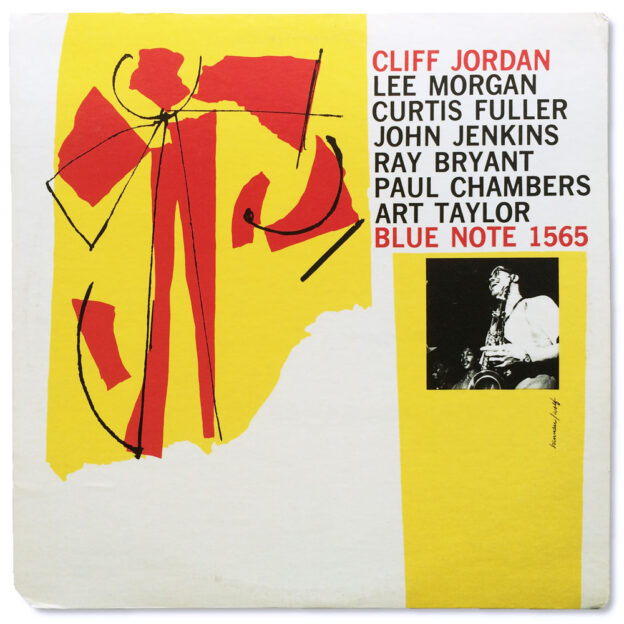
Vinyl Spotlight: Cliff Jordan (Blue Note 1565) UA Mono Pressing
- United Artists mono reissue circa 1972-1975
- “A DIVISION OF UNITED ARTISTS RECORDS, INC.” on both labels
Personnel:
- Lee Morgan, trumpet
- Curtis Fuller, trombone
- John Jenkins, alto saxophone
- Cliff Jordan, tenor saxophone
- Ray Bryant, piano
- Paul Chambers, bass
- Art Taylor, drums
Recorded June 2, 1957 at Van Gelder Studio, Hackensack, New Jersey
Originally released October 1957
Selection:
“Blue Shoes” (Fuller)
Truth be told, these United Artists mono pressings from the early to mid ’70s are hit and miss, having heard more than one that suffered from significant non-fill problems. But this particular copy made it through that inconsistent manufacturing process unscathed. United Artists pressings also seem to have a gentler top end than a lot of modern audiophile reissues, which to some collectors makes them worth seeking out despite the difficulty in finding a quality copy.
This particular Cliff Jordan album also seems difficult to find in any format, which is why I jumped at the chance to buy it when it popped up on eBay. Discogs indicates that it has only been issued in the US twice on vinyl (originally in 1957 and this copy in the early ’70s) and never on CD. Though it has been reissued by Toshiba EMI in Japan once as an LP in 1984 (undocumented by Discogs) and three more times on compact disc there, these copies are hard to find in the states. And try you may, but you will not find these sides in any shape or form on iTunes or Spotify, making this a rare and special listen indeed.
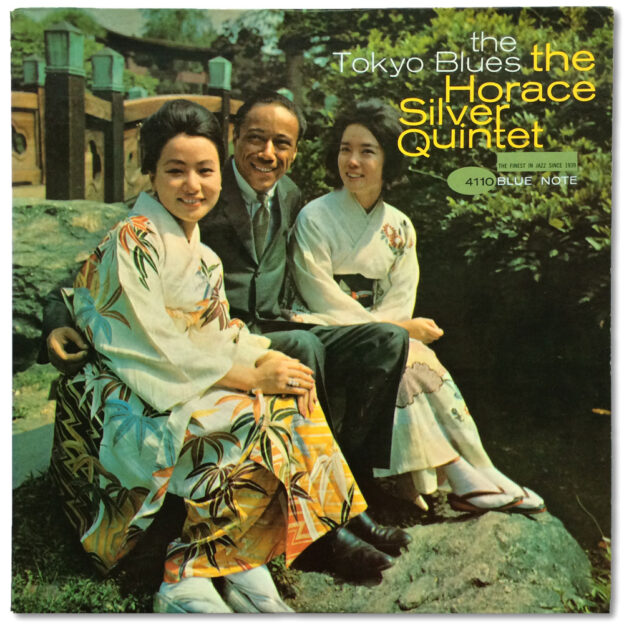
Vinyl Spotlight: The Horace Silver Quintet, The Tokyo Blues (Blue Note 4110) Original Mono Pressing
- Original 1962 mono pressing
- “NEW YORK USA” on both labels
- Plastylite “P” etched and “VAN GELDER” stamped in dead wax
- “43 West 61st St., New York 23” address on jacket without “Printed in U.S.A.”
Personnel:
- Blue Mitchell, trumpet
- Junior Cook, tenor saxophone
- Horace Silver, piano
- Gene Taylor, bass
- John Harris, Jr., drums
Recorded July 13-14, 1962 at Van Gelder Studio, Englewood Cliffs, New Jersey
Originally released November 1962
| 1 | Too Much Sake | |
| 2 | Sayonara Blues | |
| 3 | The Tokyo Blues | |
| 4 | Cherry Blossom | |
| 5 | Ah! So |
Selection: “Sayonara Blues” (Silver)
This record is one of the finest examples of engineer Rudy Van Gelder’s original mono mastering work in my entire collection. Granted, I only own a handful of these, but I’ve had dozens more pass through my hands over the years and this is definitely one of the good ones. What makes it one of the best? Condition. Since so many original Blue Notes seem to have suffered groove damage at the hands of primitive playback equipment, I have found that the key ingredient in a stellar-sounding original is the extent to which past usage has left its mark on the record. Not only does this record look amazing 55 years after it would have been taken home from the store, the sound is still fresh and vivid — the way you might expect it to have sounded back in 1962.
It’s possible that bandleader Horace Silver’s choice of a Far Eastern theme influenced drummer John Harris Jr.’s choice of a more minimal, sparse style of playing throughout, which gives each instrument plenty of room to breathe and cut through. (Less percussive energy also provides less of a challenge when getting the music onto tape and into the grooves of the wax.) The standout moment here is Silver’s four-and-a-half-minute romp on the keys in “Sayonara Blues”, a solo with trance-like qualities reinforced by a two-chord, left-hand mantra.
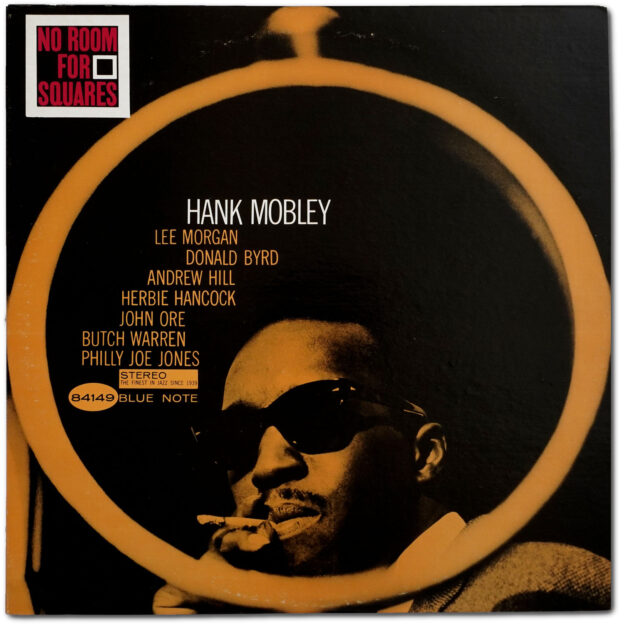
Vinyl Spotlight: Hank Mobley, No Room for Squares (Blue Note 84149) UA RVG Stereo Pressing
- United Artists stereo reissue circa 1975-1978
- “VAN GELDER” stamped in dead wax
Personnel:
All but “Up a Step”, “Old World, New Imports”:
- Lee Morgan, trumpet
- Hank Mobley, tenor saxophone
- Andrew Hill, piano
- John Ore, bass
- Philly Joe Jones, drums
“Up a Step”, “Old World, New Imports” only:
- Donald Byrd, trumpet
- Hank Mobley, tenor saxophone
- Herbie Hancock, piano
- Butch Warren, bass
- Philly Joe Jones, drums
“Up a Step”, “Old World, New Imports” recorded March 7, 1963
All other selections recorded October 2, 1963
All selections recorded at Van Gelder Studio, Englewood Cliffs, New Jersey
Originally released May 1964
| 1 | Three Way Split | |
| 2 | Carolyn | |
| 3 | Up a Step | |
| 4 | No Room for Squares | |
| 5 | Me ‘n You | |
| 6 | Old World, New Imports |
Selection:
“Three Way Split” (Mobley) [Stereo]
“Three Way Split” (Mobley) [Summed Mono]
So far on Deep Groove Mono, we’ve covered original pressings, Liberty pressings and early ’70s United Artists pressings of classic albums released by the beloved Blue Note label. This ’70s copy of Hank Mobley’s No Room for Squares with the all-blue label and the white (sometimes black) lowercase “b” logo is more or less the last phase in vintage US Blue Note pressings. (Prior to the current era of audiophile reissue programs, which gained great momentum in the late ’90s with Classic Records, the ’80s and ’90s saw a series of less popular, less acclaimed reissue programs eclipsed by the advent and subsequent reign of the compact disc.) This reissue program also constitutes the last time the original mastering work of engineer Rudy Van Gelder would be used to press reissues of classic Blue Note albums.
As is the case with the earlier mono UA reissues of the early ’70s with the classic blue-and-white label scheme, these all blue-label reissues seem hit or miss. This is at least in part due to the fact that Van Gelder’s metal work was being employed beyond the point where it could produce records of the exceptional quality originals and earlier reissues are known for. Several Blue Note albums I have encountered with all-blue-labels and Van Gelder mastering have been duds, but No Room for Squares is not one of them.
This is one of my favorite Hank Mobley albums. Recorded in 1963, it is far removed from the string of 1500-series albums Mobley recorded for Blue Note in the late fifties, all of which are very rare and in-demand in their original incarnations. Nonetheless, Mobley puts together a solid, consistent program here, best demonstrated by a pair of the leader’s own compositions (the title track and “Three Way Split”) and the ballad “Carolyn”, an original work of session trumpeter Lee Morgan. Then-veteran of the bop scene, drummer Philly Joe Jones, provides a driving and exciting performance on the skins as well.
Though this is a stereo copy, it is tempting to hit the ‘mono’ button on my amplifier in order gain a sense of what an original mono pressing might sound like. The reason we can be fairly certain that this type of summing can produce comparable results is because of what we know about the way Rudy Van Gelder recorded, mixed, and mastered these albums for both mono and stereo. Though the clarity and separation offered by the stereo spread is a treat in its own right, summing to mono provides a glue to the mix that the stereo presentation is incapable of, especially when it comes to the harmonies of the horns.

